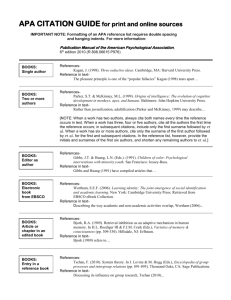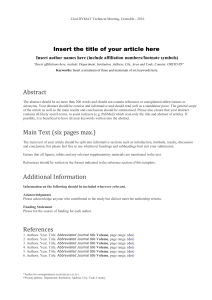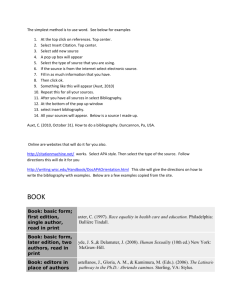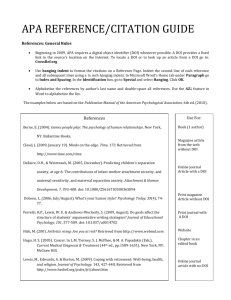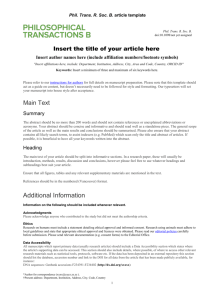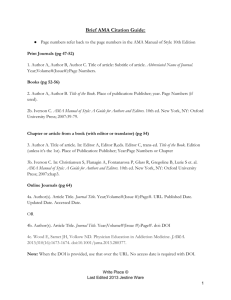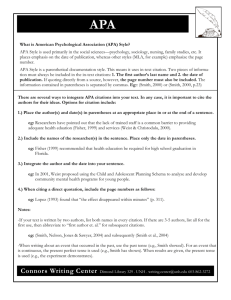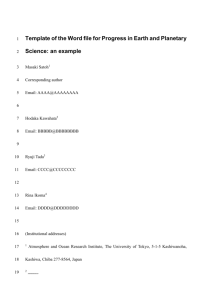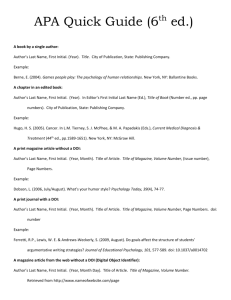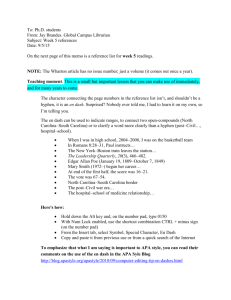Lecture slides - UNC School of Information and Library Science
advertisement
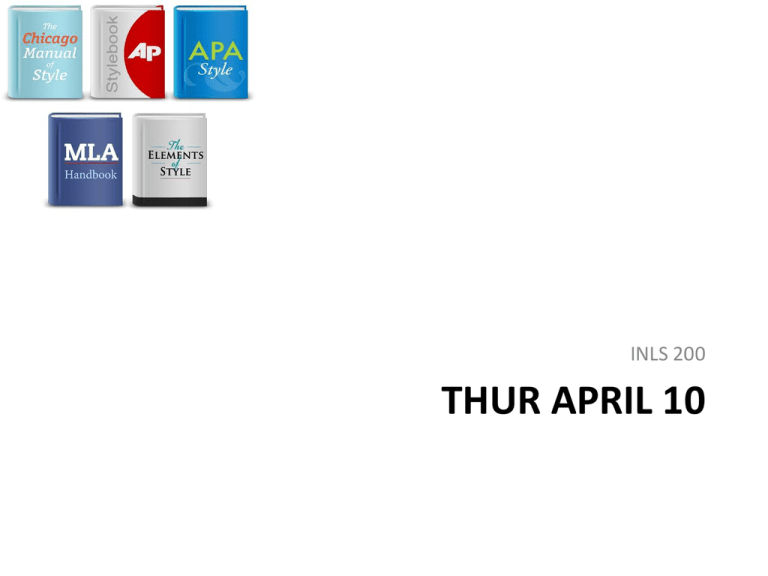
INLS 200 THUR APRIL 10 Discipline Citation Style Anthropology Chicago Manual of Style Biology Council of Science Editors. Scientific Style and Format: The CSE Manual for Authors, Editors, and Publishers. Business American Management Association. The AMA Style Guide for Business Writing. Engineering Institute of Electrical and Electronics Engineers. IEEE Editorial Style Manual. History The Chicago Manual of Style. Journalism Associated Press Stylebook Law Harvard Law Review et al. The Bluebook: A Uniform System of Citation Math American Mathematical Society. AMS Author Handbook. Medicine American Medical Association. AMA Manual of Style: A Guide for Authors and Editors. Political Science American Political Science Association. APSA Style Manual for Political Science. Psychology and other social sciences American Psychological Association. Publication Manual of the American Psychological Association. What is a style guide for? • • • • • • • How to format a paper for publication Writing style (clarity, accuracy, reducing bias) Ethics Editorial process Mechanics of style Crediting sources Displaying results Style example… • Refer to participants at the appropriate level of specificity. The manual provides the example of using women and men to refer to all human beings instead of only using man. Man is appropriate to use when referring to one man but not when referring to a population that includes men and women. Reducing bias example… • Refer to participants how they wish to be called. Try to avoid labels if possible, but if this is not avoidable, be respectful. Focus on the people and not the label. For example, instead of labeling a group “the elderly" or "the arthritic," labels in which individuals are lost, try “older adults" or "a woman with arthritis." Mechanics example… • Punctuation—the sixth edition of APA returns to two spaces after the period at the end of the sentence recommended for ease of reading comprehension. Crediting sources example… • References that appear in the text must appear in the references list in alphabetical order by the author’s last name, with the exception of personal communication; only cite personal communication in the text, not in the reference list. APA Reference List • Order: Entries should be arranged in alphabetical order by authors' last names. Sources without authors are arranged alphabetically by title within the same list. • Authors: Write out the last name and initials for all authors of a particular work. Use an ampersand (&) instead of the word "and" when listing multiple authors of a single work. e.g. Smith, J. D., & Jones, M. • Titles: Capitalize only the first word of a title or subtitle, and any proper names that are part of a title. • Pagination: Use the abbreviation p. or pp. to designate page numbers of articles from periodicals that do not use volume numbers, especially newspapers. These abbreviations are also used to designate pages in encyclopedia articles and chapters from edited books. • Indentation*: The first line of the entry is flush with the left margin, and all subsequent lines are indented (5 to 7 spaces) to form a "hanging indent". APA Cheat Sheet handout What is a DOI? • A digital object identifier (DOI) is a unique alphanumeric string assigned by a registration agency (the International DOI Foundation) to identify content and provide a persistent link to its location on the Internet. The publisher assigns a DOI when your article is published and made available electronically. • http://www.doi.org/ • The DOI system provides a technical and social infrastructure for the registration and use of persistent interoperable identifiers, called DOIs, for use on digital networks. Journal article, one author, accessed online Ku, G. (2008). Learning to de-escalate: The effects of regret in escalation of commitment. Organizational Behavior and Human Decision Processes, 105(2), 221-232. doi:10.1016/j.obhdp. 2007.08.002 Journal article, more than two authors, accessed online Van Vugt, M., Hogan, R., & Kaiser, R. B. (2008). Leadership, followership, and evolution: Some lessons from the past. American Psychologist, 63(3), 182-196. doi: 10.1037/0003-066X. 63.3.182 Journal article from a subscription database (no DOI) Colvin, G. (2008, July 21). Information worth billions. Fortune, 158(2), 73-79. Retrieved from Business Source Complete, EBSCO. He [the author] notes that "peer review as practiced in the 21st century poisons science." Do you agree with this statement? I view peer-review as the final step in good research, yet this author sees it as a deterrent to good research. Do you put as much trust in an article if you know it is not peer-reviewed? Do you think changing the peer-review system would benefit research? -Hayley In a perfect world, ideally, valid, trustworthy, factual, and worth information would be easily accessible on the internet for everyone to use to their reference for free. But this is just not possible. Studies spend much time and money to be completed, and thus sent for "peer review" which the author takes a negative stand on. He thinks that sending work for peer review is "a stupid tradition." Do you believe that this statement is true, or that it is necessary for the integrity of scientific work? -Sarah http://www.sparc.arl.org/resources/resource-type/webcasts-videos-podcasts INFORMATION IS NOT “FREE” – IT IS A COMMODITY! INFORMATION WANTS TO BE FREE! http://publicaccess.nih.gov/policy.htm http://www.sparc.arl.org/news/omnibus-appropriations-bill-codifies-white-housedirective
